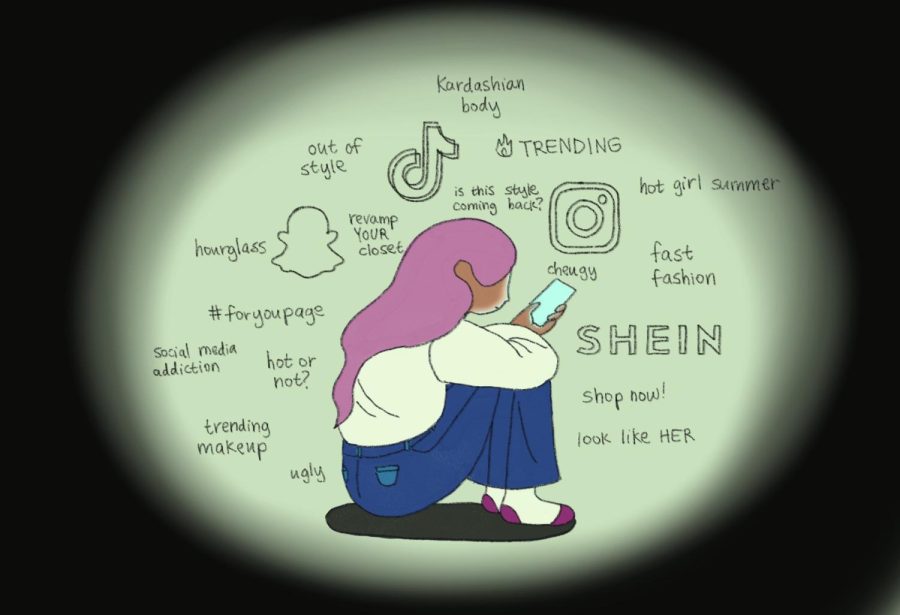Negative Effects of Social Media Trends and Fads
The endless cycle of social media trends is extremely damaging to users’ self-image.
Nearly 60% of the world’s population uses social media – there’s no doubt that social media plays a massive role in our global society today. An arguably large part of why social media has gained such a widespread following is how interactive it is. Unlike news websites, or cable TV, social media gives people the opportunity to create their own content, as well as somewhat customize the content they see. With the use of “cookies,” these social media apps’ algorithms are able to place certain videos in front of target audiences that are sure to interact with the video, and boost the video on that platform. This creates somewhat of a domino effect: the more people interact with a video or photo, the more people are going to see it as a result of that.
This type of content that is customized to a user’s interests finds an outlet on things like the “For You Page” on TikTok or the explore page on Instagram, both of which fuel a video or photo’s chances of reaching a widespread audience. While I know I personally have used these features to find new content creators or engage with content I typically gravitate towards, I have also seen the way these engines boost certain things over and over, and not always for the best interest of the users. These algorithms have the power to spread ideas, creators, or topics all over the internet, popularizing certain ideas and establishing trends. But I believe there is a bigger effect behind the patterns – behind the likes and the shares – and the way we as a society respond to what is seen as “popular” at any particular point in time.
To start off, there’s no denying that one’s physical appearance has started to be a dictating factor of whether or not they are able to gain widespread praise on the internet. With just a few scrolls on TikTok, you are almost guaranteed to see someone showing off their side profile, or using some sort of beauty-enhancing filter. I don’t think anybody has a problem with these people being confident or showing off their bodies on the internet; the problem comes in when the same exact type of feature is constantly being praised.
Over the last few years on social media, I have observed the way in which certain body shapes seem to go in and out of style. For example, the presence of socialites like Kim Kardashian popularized the “hourglass” body type – a body in which someone’s waist is small enough to make one’s torso appear like an hourglass. Within a few months, videos of people attempting to emulate, or show off this body type suddenly appeared all over social media. This includes videos of young girls wearing baggy shirts, pulling it tight on their body to reveal their figure, or people using tracing tools to draw their body figure on the screen in white ink. While this empowers those who are “lucky” enough to have this body type, it inherently puts down those who don’t. Constantly seeing videos of people participating in this trend is likely to encourage those watching to join in, too, and spark a desire to emulate a certain body type they might not naturally have.
It is a harsh reality when a young person looks at their screen and realizes they don’t have the “right” type of shape to participate in the trend. With the natural human desire to fit in, someone could very likely continue to attempt to get this type of body in order to hop onto the bandwagon and gain some praise on these apps. This isn’t right. Nobody should feel so bombarded by trending videos that they feel the need to change their body simply to join a trend. Of course, it’s okay for someone to want to change their body if their sole motivation is to be healthier and live a better lifestyle for themselves. But for me, the many times I have wanted to change my body, or have heard those around me express that desire, wasn’t to feel better, or be happier. It was solely in order to look more like some sort of body type that was popular at the moment; to feel as though I could fit in with the individuals I continuously saw as I swiped through my feed. The truth is, bodies should not be something that go in and out of “style.” Our body shape is something that we are born with, something that can be very difficult to change. With teens at 1 of their most impressionable stages of life, and them making up a large demographic of social media users, these idealistic body standards being plastered all over the place is not helpful for their progression. The fact that 1 person’s body can be completely praised 1 second, then become “unpopular” the next, is seriously detrimental to social media users and can leave them with crippling insecurities that may not have been present before.
Along with peoples’ physical appearance being a continuous topic on social media comes a rapidly growing community surrounding fashion. Y2K nostalgia, cottagecore, preppy, indie, and vintage all fall under the category of “aesthetics.” In pop culture, the term aesthetic refers to a particular style of someone or something, and is often used to capture certain clothing styles. For example, a “cottagecore” aesthetic is supposed to include loose-fitting, flowy, dresses, along with knitted cardigans, or loose linen pants. On the other hand, a “modern preppy” aesthetic involves pink cowboy hats, patterned ruffle skirts, and sparkly shoes. I completely believe that people should be able to find their own style, and use online tools for inspiration. But again, with a parallel to the topic of body types, I have also observed the way in which the wavering of these can have a lasting effect on the world outside of social media, and not always for the better.
It is important to recognize the direct relationship between trends and retail. In a world in which brands value profit so much, it makes sense why they would want to do anything to keep their clientele in the palm of their hands. Brands want to do whatever it takes to keep their customers willing to take a look at their inventory, and buy. Trends are very valuable to retail companies, as the presence of trends on social media provides somewhat of a key to retail companies on what is likely to make a lot of money at the moment. For example, when the indie aesthetic was trending, if a shopper looked at any website like Shein or Urban Outfitters, they would see pages filled with bright clothing, and swirly patterns, all recently stocked. These items are stocked in a ridiculously short amount of time, and are magically available for any people wanting to participate in these trends. But behind the scenes, these brands’ inevitable responses to the changing fashion environment contribute to something much bigger: fast fashion and overconsumption.
As these aesthetics continue to go in and out of style, and are constantly being reconsidered as the highest regarded level of fashion, it makes sense that any user would feel as though they should try out these aesthetics too. But the difficult thing about these trends is right in the name: they are only trending for a short amount of time, and then usually die out to make room for another phenomena. So, when consumers are looking for clothes to match these styles, they don’t really need a long-lasting article of clothing, since the trend will disappear so soon. It doesn’t make sense to spend a large amount of money on something that you likely won’t wear in a few months. Rather than turning to high quality, staple pieces, they are more likely to gravitate to the affordable, yet low-quality pieces. This continues to fuel the industry known as fast fashion, which these quickly produced, quickly-damaged goods fit into. While providing affordable clothing options to those who aren’t able to splurge all the time is 1 thing, the negative aspects of fast fashion are also very evident.
Fast fashion brands use practices that are certainly not environmentally friendly to quickly produce these goods, while also failing to maintain human work conditions in the factories these clothing items come from. With a quick Google search, any individual can see the terrible and unethical practices in these factories, as well as the amount of waste generated by this industry as a whole. The constant wavering of what is considered trending fashion has an undeniable effect on our society through the type of clothing production it encourages.
Besides the way in which trends contribute to the ever growing statistics of fast fashion, it also generates fuel for the larger issue of overconsumption. The constant pressure on social media users to replenish their wardrobe causes clothing pieces to be bought that are excessive – things that are bought at an alarmingly fast rate. A person might have an entire wardrobe of good, wearable clothes, but as soon as another trend comes along they are likely to buy even more clothes to stay up with the style. Young, impressionable users continue to buy clothes as the trends around them continue to refresh. Many of these people don’t really need another piece of clothing, but seeing how popular something is suddenly makes them feel as though it is a must-have addition to their wardrobe. They are likely to find themselves with an entire collection of clothes that they couldn’t really see themselves wearing, but simply bought in order to partake in a certain trend. The constant cycling of what is considered fashionable to wear often promotes a very wasteful and excessive lifestyle.
Circling back to the concept of how closely tied body image is to social media, fashion trends can contribute to this feeling of exclusivity, as if only certain people are able to participate in certain things. Take for example, the seemingly minute phenomena of low rise jeans. As soon as this type of clothing item became popular, it seemed as though overnight you could see young girls on social media making fun of themselves for the way they looked in them, comparing the way their stomach looked compared to other celebrities or influencers who popularized the article of clothing. The way in which fashion trends tend to highlight certain aspects of a person’s body, like a flat lower stomach in the case of low rise jeans, can heighten insecurities for people who don’t believe that they themselves possess these features. It is extremely concerning how popularized fashion trends can make certain features more or less appealing, and can therefore lead to poor body image amongst users.
All in all, it is evident that social media has continued to warp our minds into believing that whatever we already has isn’t good enough. As soon as we start feeling confident about the way our body looks, it goes out of “style.” As soon as we start figuring out what kind of style we like, it becomes “cheugy” or uncool. We as a society preach the idea of self-love, but completely push aside anything that seems removed from what is “in.” This constant fear of not being trendy enough continues to fuel harmful ideologies, resulting in a dependence on even more harmful industries.
I believe that in order to encourage every individual to live their life in a healthy way, we must be accepting of the way everyone presents themselves, even if it isn’t what is trending online at the moment. We must break free from the toxic cycle of trends, and understand that everyone has something unique and special about them that should be praised: not through likes or through shares, but through the way we empower and uplift each other on a day-to-day basis.
Your donation will support the student journalists of Campolindo High School's The Claw. Your contribution will allow us to produce more issues and cover our annual website hosting costs.

Freshman Ruthie Stoll is a dancer, tennis player, and foodie. She grew up in a small town in Pennsylvania, moved to the Bay when she was 4, and just graduated...

Senior Haelee Chung (she/her) is a new member of the art staff at the Claw. Haelee’s been painting and drawing all her life, and loves to express her...




